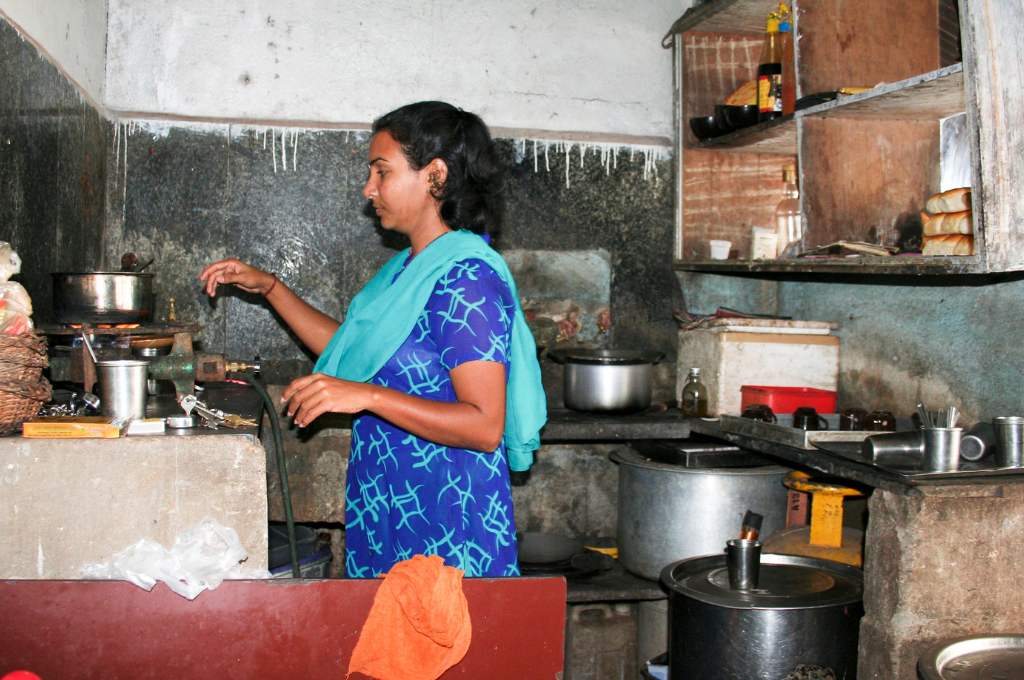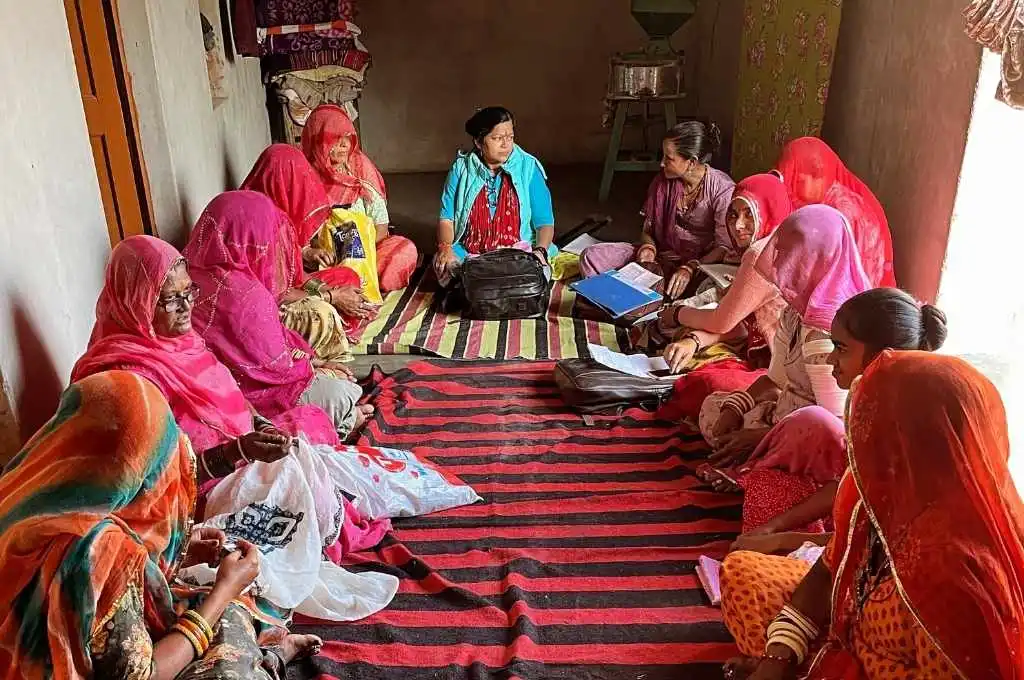In southern Rajasthan, male migration has traditionally been a common phenomenon among the Adivasi community due to destruction of natural habitats and limited work opportunities.
Environmental degradation coupled with financial constraints have pushed many men to look for work elsewhere. However, a new trend has emerged. Newly married women from Udaipur’s Gogunda Block migrate with their husbands to Gujarat and Maharashtra and work in the kitchens of hotels and hostels.
We previously had a limited understanding of women’s migration, focussing mainly on the trend of families from Banswara district moving to Gujarat and Madhya Pradesh, primarily for construction work. Our prior knowledge of the working conditions for women and adolescent girls portrayed a grim picture, marked by physical exhaustion, persistent malnutrition (even during pregnancy), and the constant specter of sexual harassment.
However, our conversations with women from various villages in Gogunda revealed a complex nature of migration, shaped by intricate societal structures. Some of these women we spoke with were visiting to help families for the Kharif crop season, or have returned to their homes permanently, because they dared to speak up for themselves.
No entitlement, lack of options
These women shared their diverse experiences and varied impacts of migration on their lives and families.
Tara, a mother of three young daughters, Ganga, Monika and Geeta, works in a hotel in Rajkot with her husband. For the last four years, she has been cooking in the hotel’s kitchen. She has left behind two of her daughters with her relatives in Gogunda.
“They only allow one child to stay with us and since Geeta is the youngest, she travels with us. We have enrolled the other two in a school there [in Gogunda], but they are not consistent because nobody keeps an eye on them,” says Tara. Her expression showed how she has been left with an agonising choice—leaving behind her two children, and the wage she seeks to earn to take care of them.
However, Tara’s main concern lies with her husband’s drinking habits. When they are at the workplace, everything seems fine. Tara feels content and her husband remains sober, as alcohol is strictly prohibited within the campus.
However, as soon as they return to their home in Gogunda, her husband starts drinking again. This leads to frequent arguments and even physical abuse, leaving Tara deeply troubled.
“I live like you there,” she pointed out to our attires. “I just apply sindoor and nothing else is compulsory. I can wear a suit, or even a saree,” she says, as if shedding the heavy burden of wearing a traditional lehenga choli offers her respite.
Tara isn’t the only woman who doesn’t want to come back to her village after working in a big city like Rajkot or Ahmedabad. Women workers are torn between the worlds they inhabit; they stand between the societal expectations of leaving work for family and the different life cities offer.
The gap between these two worlds is quite evident.
Sonu, 23, a mother of two, came back to her husband’s village Dadiya, during the COVID-19 pandemic and never went back.
She first went to Ahmedabad when she was 10 years old, with her uncle who worked at the airport. “It was not my first time living away from home. I went with my uncle and lived there for two years. I wanted to see the aeroplanes and thought I could study anytime but this is my only chance to go out and see them taking off,” her eyes sparkle as she recalls those days.
Even after getting married at the age of 12, she found the courage to speak up about her previous experiences. “I am not afraid ma’am. During one of our jobs, my husband and I were made to stay along with other men because there were not a lot of women working in those spaces back then. I raised my concern and asked my husband, who is quite understanding, to get work somewhere else,” she says.
“We just had one task to do there—I used to clean the kitchen and in turn, I was getting good food and the privilege of working in a place with a functional fan,” she adds.
She came back to Rajasthan when her sons grew up and needed to enroll in school. Her migration, which once gave her an opportunity, now seems like a distant memory. There are Gujarati-medium schools mostly, and the Hindi-medium ones are expensive. Because of the inaccessible education system, she is compelled to stay behind.
As private ownership grows and public education declines in the state, inequalities between disadvantaged and privileged groups have become more apparent. The lack of access due to language barriers keeps the cycle of marginalisation going.

An identity crisis
Another concern emerged during our conversations—that despite their vital contributions, women failed to recognise themselves as workers.
Women working alongside their husbands raises intriguing questions about the evolving migration patterns. To truly understand this shift and the motivation behind women’s inclusion, it is imperative to delve into the complicated ways in which both men and women perceive women’s roles in this process.
When asked about her decision to accompany her husband to Ahmedabad, Ganeshi Bai’s response was rooted in the belief that she was needed to assist him.
“Everyone said he is already working, and you will work in the kitchen only at home. So, why not help your husband with his work,” she says.
Her response also shaped her perception of her role as a wife and a worker.
Many women find themselves cast into the role of a ‘helper’. However, this seemingly innocuous term conceals a significant imbalance. It also reveals a subtle yet significant form of labour exploitation since it diminishes the magnitude of their work, demoting them to a position devoid of the rights that a recognised worker would command. This linguistic choice effectively deprives these women of the entitlements that should rightfully accompany their labour.
In Obra, a quite remote village in the block, where opportunities are limited, catering contracts have become increasingly popular, attracting numerous young couples who are hired by the subcontractors and contractors to cities like Rajkot and Ahmedabad.
Hansa, 22, a mother of one, confidently shares her story. She and her husband primarily earn from catering services, where they are paid Rs 500 per day. However, if they secure a monthly job at a hotel, they are paid Rs 15,000 combined.
“I said I also want to go with him because I heard other women from many villages go and help their husbands in the kitchen. I studied till 9th grade. I can keep an account of our salary,” she says.
Awareness about the complexities surrounding labour migration, the need for a consistent income, and the importance of labour rights are crucial for female workers.
As we visited Hansa’s home in Obra, we were greeted by a modest kuccha house, barely spacious enough to accommodate her family of six adults along with a dozen farm animals. Such living conditions were common among families in the village.
“We came back to the village for my first delivery, which was seven months ago. My husband will go back [to the city] when he gets some work. Then I will also go after two to three months to work [in the city],” she adds.
Although the uncertain nature of these contracts may expose them to an unreliable employment environment, Hansa and other women from her village do not seem to care about the lack of stability because of the abundant opportunities this migration offers.
However, an awareness about the complexities surrounding labour migration, the need for a consistent income, and the importance of labour rights are crucial for Hansa and her peers as they aim for a more secure and empowered future.
These stories, however, raise an important question. Why are women now being included in these migration ventures when historically they had been kept out? The answer to this question lies in the concept of enlisting women as ‘helpers’, which strategically eliminates the need to hire two separate individuals for kitchen-related tasks.
Contractors keenly seize upon this ploy: by encouraging male workers to bring their wives along, they can avoid the expense of hiring two men because then they can pay two individuals, a husband and a wife, a combined wage that is often lower than what two male workers would individually command.
The contractors’ cost-saving strategy, however, becomes unfavourable to women as it does not allow them to explore their identity as an independent worker. This approach also highlights how gender, migration, and economics intersect, showing the ongoing struggle for women to be treated fairly and paid equally.
Kailashi, 21, shared her experience as a migrant labourer. “I was not paid for the work, only my husband did, and at night, all the kitchen staff used to sleep together in the kitchen,” she says.
When she came back from Maharashtra due to the COVID-19 pandemic, Kailashi found her in-laws’ home overcrowded, with six people crammed into a single room.
When she demanded her husband to provide her and their son a separate living space, he abandoned her and sent her back to her maternal home. In the process, her husband also took her son away, she says.
“I never wanted to get married, and now I don’t know what I will do with the rest of my life,” she says, while working on her father’s farm.
Kailashi’s story reveals how women are treated when they seek empowerment.
It also highlights the dire need for a systemic change that upholds women’s rights, recognises their worth, and safeguards their aspirations within the broader theme of migration and society.
Furthermore, these stories also call for the need for a more comprehensive approach to address the multifaceted issues women face, including access to education for children and the intricacies of marital dynamics in the context of migration.
This article was originally published on The Wire.






